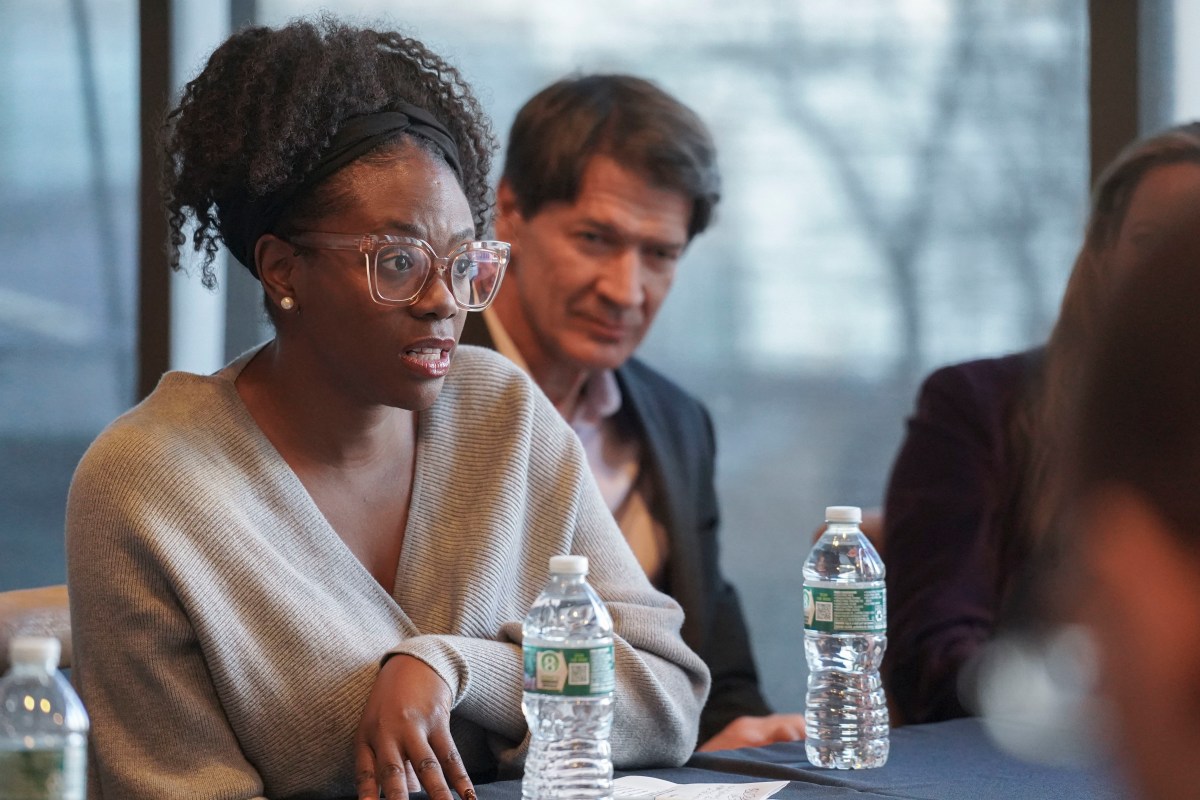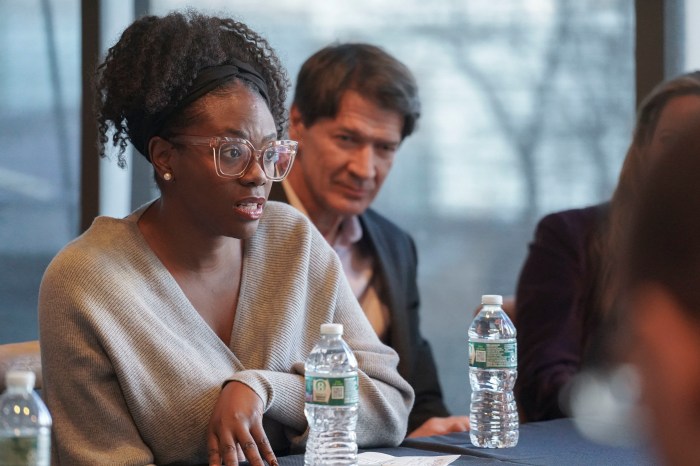By JERRY TALLMER
Near-complete works of the French director to be shown
Louis Armstrong said: “If you have to ask, you’ll never know.” He wasn’t talking about that new squirt on the block, Miles Davis, he was talking about the whole thing called jazz.
With the first white-hot note – a series of squeezed-out, throttled, high-pressure, steam-bursting trumpet notes of pain and purity behind the first frames of “Elevator to the Gallows,” you are already pointed the way through the ensuing 91 minutes of Louis Malle’s first, shockingly alive, full-length motion picture.
Wandering with you the whole night long through the streets of Paris – to the sound of Miles, the devil’s own music – is Jeanne Moreau, in search of a man, her lover, who unbeknownst to her is trapped in an ascenseur, an elevator, six or eight stories up in the apartment building where, as she wished, he has just murdered Moreau’s husband.
She sees the lover’s car drive away, and thinks he’s two-timing her with the young chick Moreau has glimpsed on the front seat, but it wasn’t Moreau’s lover at the wheel of the car, it was the chick’s tinhorn daredevil boyfriend who has stolen the snazzy vehicle … and these two teenagers will stumble idiotically into a double shooting that wipes out the first murder — almost.
Those banshee notes of Miles the magician punctuate and drive the whole crackling irony. Miles and a pickup combo. Free-lancing.
Louis Malle was 24 when he wrote (with Roger Nimier) and directed this 1957 thriller, which, thanks to the restoration and reissue of “Elevator” by Bruce Goldstein’s Rialto Pictures, on Friday, at the Walter Reade Theater, opens the Film Society of Lincoln Center’s long-in-the-making 26-day near-complete retrospective of the cinema of Louis Malle. The same day, “Elevator to the Gallows” is making a theatrical re-release at Sunshine Cinemas for an indefinite run, a nation-wide release of the film will follow.
Miles Davis was 31 and happened to be on a club date in Paris in 1957. “I was crazy about jazz,” Malle has said of that moment – and would prove his love of jazz again, a decade and a half after “Elevator,” with his 1971 “Murmur of the Heart” (“Le soufflé au coeur”), in which, in the bleak Dien Bien Phu year of 1954, a gawky 15-year-old Parisian kid named Laurent is nuts about Charlie Parker while we hear Bird and Bechet scatting around on the soundtrack.
The next year, 1955, Charlie Parker was dead – and all over New York City, and everywhere else, for all I know, the two words “BIRD LIVES” sprouted in chalk, in paint, in charcoal, in ink, on surfaces wherever your eyes would fall. I myself first saw it, BIRD LIVES, where you go down into the subway at Sheridan Square.
Back to Paris and ”Ascenseur pour l’echafaud”:
The 24-year-old Malle, most of whose movie-making experience to that point was helping Jacques Cousteau shoot his underwater documentary “The Silent World,” wangled an introduction to a reluctant Miles Davis.
“I managed to convince him” [to put music to the work in hand, Malle would write in “Malle on Malle”], “I showed him the film twice, only twice. We agreed on the parts where we felt music was needed. And we took advantage of the one night off he had from the club. We rented a sound studio in Paris on the Champs-Elysees, and started working, as musicians do, very slowly. We worked from something like 10 or 11 that night until 5 in the morning. In that one night, the whole score was recorded … It’s one of the very few film scores which are completely improvised.”
Jeanne Moreau doesn’t do much in the movie – except, as was once said of Laurette Taylor, she does everything. Does it just walking around. Does it just by having the camera – Henri Dedae’s camera – stay on her face.
Before this, Moreau was already worshipped in the theater, but in films, as Malle noted, was only a B star. “[P]eople used to say that although she was a great actress, and very sexy, she was simply not photogenic.” Hah! See “Les amants” (“The Lovers”), by Malle the very next year, 1958. It was “Elevator to the Gallows” that had made her an A star – and Louis Malle, on one try, an A director.
Part of the plot of “Elevator” is set in, of all environments, a motel. Malle couldn’t find one in all of Paris. He had to take his actors and crew to Normandy, D-Day territory, to find the only motel in France.
In that motel we meet a couple of German tourists, man and wife, he an overbearing traveling salesman who quotes Goethe and reveals, not too far between the lines, everything Louis Malle, born 1932, would feel and think about Germans – and, 30 years after “Elevator,” would put into the wrenching, autobiographial “Au revoir les enfants,” about the day the Germans came in 1944 and took three Jewish kids out of the Catholic school (Malle’s school) where they’d been sheltered.
Louis Malle was, above all, a humanist. Could even study with humane eyes the banality of evil, viz., “Lacombe, Lucien” (1974), an exploration of the life and times of a 17-year-old French misfit who goes to work for the Gestapo.
It is a long way from there to “Pretty Baby” (1978) and even farther to “Atlantic City” (1980), both of which made Susan Sarandon on object of any man’s deep desire. And if there is anything more humane than 67-year-old Burt Lancaster’s quiet pride the morning after making love with a stunner half his age, I don’t know what it is. It almost matches Lancaster’s line – well, John Guare’s line – “You should have seen the ocean in those days.”
I interviewed Louis Malle two or three times, here in New York, and we got talking of this and that. Once, a propos “Pretty Baby” and its nude 12-year-old Brooke Shields, we discussed voyeurism. Malle, who had spent many separate months over a number of years making a series of documentaries on India, said: “You know, some of the people in India, when you point a camera at them, they think you are stealing their soul.” He let that sink in, then added: “Maybe I AM a voyeur.”
I asked him how he could have ever, in real life, let Susan Sarandon go. He just looked at me. Maybe it wasn’t he who’d let go. Another time, on the subject of “Au revoir les enfants,” Malle, born and raised Catholic, said he rather thought there was a Jewish grand- or great-grandparent somewhere back along the line.
Things like the schoolboy opening passages of “Murmur of the Heart” have a way of getting under your skin. It’s like being born again. “Le souffle au coeur” is famous for the daring, and tenderness, of its climax, lonely young guiding mama (Lea Massari) and sexually uptight teenage son (Benoit Ferreux) in bed together in a hotel room in the dark.
We go to movies, to plays, to better understand our own lives. What broke upon me, this time round, somewhat earlier in the film’s 110 minutes, was something that had floated past in any previous viewing over the years: just a quick shot of mother and son playing tennis together at the spa.
Suddenly I had a flashback, to a resort, not in France, but here in the Delaware Water Gap, where, at something like age 15 – the age of the boy in the movie – I am playing tennis with my own mother. In the next court are a fellow and girl who, when all of us are cooling out with towels in hand, come over and exclaim: “Oh, what a lovely couple you two make! Are you on honeymoon?”
No, I did not go to bed with my mother, nor want to. But obviously, my subconscious never forgot that instant. “Murmur of the Heart” – Louis Malle — brought it out.
Then there’s this: Sometime in the 1980s or early ’90s, the New York Post was going through on of its periodic death throes. Very late one desperate night, we of the staff are sitting around the City Room down on South Street, sweating blood, while our entire fate – live or die – is being decided by cold-blooded negotiators closeted for endless hours in a hotel room 60 blocks north.
Suddenly the phone on my desk starts ringing. I pick it up. It is Louis Malle, world-famous director of motion pictures. “I was just worrying about you,” he says. “Are you all right?”
Louis Malle was taken by cancer on November 23, 1995.
The series at the Walter Reade is subtitled “Risks and Reinvention.”
MALLE LIVES.
WWW Downtown Express































